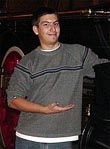|
|
This topic comprises 2 pages: 1 2
|
|
Author
|
Topic: Digital sound.
|
Stephen Furley
Film God

Posts: 3059
From: Coulsdon, Croydon, England
Registered: May 2002
|
 posted 08-26-2007 04:52 PM
posted 08-26-2007 04:52 PM




I've just been to see 'The Simpsons Movie' at the local multiplex. I've not been there before; some things were good, some were bad, but that's another story. They could certainly do with more staff; not only could I not find anywhere to buy a ticket, I couldn't even find anybody to ask where I could buy a ticket! Eventually I found a few self-service credit card machines, rather hidden away, but surely there must be a box office somewhere. What happens if you haven't got a credit card?
Both adverts/trailers and the feature were in some digital sound format, as there were split surrounds, it was most likely Dolby.
They ran Pearl & Dean adverts, though rather more than we do, and no less than five trailers, about 25 minutes in total, which seems a bit excessive; the feature wasn't much more than an hour and a half.
For the last few weeks P & D have been sending in the adverts reel with a slight gap at some of the splices, so if you don't bloop them you get a click on the analogue track as they go through. There are also annoying mid-frame negative splices in the black before some of the adverts (why?) which need painting out, and which they hadn't done. But wait, I said they were running digital sound, but we still got the click between many of the adverts; I wouldn't have expected this. What was going on? Was the system reverting to analogue just as the splice went through, so we were hearing the analogue track at that point? This didn't happen at any of the splices in the feature.
I don't have much experience with digital sound (on film) most of the cinemas I use don't have it, and many of the films I watch don't either. I think I've heard DTS twice, SDDS once and Dolby about six times, and run it myself once.
[ 08-28-2007, 05:19 AM: Message edited by: Stephen Furley ]
| IP: Logged
|
|
|
|
Thomas Pitt
Master Film Handler

Posts: 266
From: Leeds, West Yorkshire, UK
Registered: May 2007
|
 posted 08-26-2007 05:37 PM
posted 08-26-2007 05:37 PM




Stephen, was it a VUE cinema? They have a system called "Ticket At Any Till" - meaning you don't have to go to the box office to buy a ticket. You can buy one from the refreshment stand, or sometimes from one of the floor staff who will just go to a terminal.
Back on topic, I myself have never experienced DTS sound. The two VUE cinemas I go to both have Dolby Digital, and I've been to a Cineworld a couple of times that has SDDS.
I've heard the digital sound drop out to analogue several times during the Pearl & Dean snipe, as if a splice wasn't made correctly. What I do know is that if the error rate gets too high, both SDDS and Dolby will instantly switch back to the analogue soundtrack until the error rate goes back down again. This stops you hearing digital errors such as white noise, repeating segments of sound etc. when the digital 'noise' is high.
I'm also guessing the splicing tape can obscure the digital data enough for the error rate to go high and cause the analogue switchover. I've certainly heard analogue switchovers in the middle of a movie, often when the film is dirty/damaged or has a splice.
This is also the reason why cinemas are supposed to leave on the MPAA/BBFC card at the beginning of each trailer. If you splice it out (most VUEs do), you'll often get an analogue switchover at the start of the trailer - switching back to digital a couple of seconds later. This makes the start of the trailer sound odd to the audience.
Also, taking one of the Surf's Up trailers as a good example. If you splice out the BBFC certificate at the beginning and just go straight onto the trailer, you'll mute a bit of dialogue at the very beginning!
| IP: Logged
|
|
|
|
|
|
|
|
|
|
|
|
|
|
Stephen Furley
Film God

Posts: 3059
From: Coulsdon, Croydon, England
Registered: May 2002
|
 posted 08-27-2007 02:45 PM
posted 08-27-2007 02:45 PM




Is it really that long? I saw 'Schlindler's List in DTS at the Empire Leicester Square, and Dolby was out before that, so I suppose it must be getting on for that long now.
Many of the films that I watch are several decades older than that, though I suppose some may have had the sound re-recorded on digital tracks for new prints. The majority of the cinemas where I see films do not have digital sound installed, at least not for film. I've shown several recent independent films that did not have digital tracks, though most do.
We only have digital sound for digital cinema, but at least two of the films that we've run in digital, and we've probably only run about ten films in total on the digital projector so far only had two channel sound. One was 'This is England', which is still sitting on the server as it's coming back next Month for it's third run; I can't remember what the other one was, but in was the first digital film we ran after we had the sound system upgraded to split surrounds. I was disappointed because it was the first digital film we'd run for several weeks, and I was looking forward to hearing the upgraded sound system. New amplifiers had also been installed, and a faulty Cat. 441 card replaced.
Not everything is in digital, and not everything in digital is six channels. Strictly speaking, I think the two channel films are actually six channels, but with four of them silent, as the DMA doesn't see them as a two channel source and allow the matrix decoder to be used, so you only get sound out of two speakers.
I noticed something strange about the sound on 'Becoming Jane', which I think was the second digital film we ran. The lights on the DMA were showing nothing on the Ls and Rs channels, but there was a signal much of the time on the normally unused channels 7 and 8. Despite this there was sound on the surround speakers.
| IP: Logged
|
|
|
|
Brian Guckian
Jedi Master Film Handler

Posts: 594
From: Dublin, Ireland
Registered: Apr 2003
|
 posted 08-27-2007 04:38 PM
posted 08-27-2007 04:38 PM




quote: Stephen Furley
They ran Pearl & Dean adverts, though rather more than we do, and no less than five trailers, about 25 minutes in total, which seems a bit excessive; the feature wasn't much more than an hour and a half.
Many adverts in the UK and Ireland are still Dolby SR-only, and thus there will be several reversions during shows, not to mention if policy logos etc. are also in SR.
If reversions are very noticeable then it suggests the analogue chain is not being kept tuned ![[Frown]](frown.gif)
Also, in Ireland at any rate, some of the Distributors have been releasing local short films before features for the last few years, many of which still have SR-only soundtracks.
quote: Stephen Furley
Not everything is in digital, and not everything in digital is six channels. Strictly speaking, I think the two channel films are actually six channels, but with four of them silent, as the DMA doesn't see them as a two channel source and allow the matrix decoder to be used, so you only get sound out of two speakers.
Interesting - is this an example of Dolby E? Or is it a standard Lt Rt track? (But if so, that would be 4.1, not 5.1, when decoded).
Can the DMA-8 matrix decode Lt Rt, and can it decode Dolby E as standard, or are all these features additional extras?
Also wondering why your installation isn't decoding the tracks - the films in question could hardly have been mixed only in L-R stereo?
| IP: Logged
|
|
Stephen Furley
Film God

Posts: 3059
From: Coulsdon, Croydon, England
Registered: May 2002
|
 posted 08-27-2007 05:32 PM
posted 08-27-2007 05:32 PM




quote: Brian Guckian
Interesting - is this an example of Dolby E? Or is it a standard Lt Rt track? (But if so, that would be 4.1, not 5.1, when decoded).
Can the DMA-8 matrix decode Lt Rt, and can it decode Dolby E as standard, or are all these features additional extras?
Also wondering why your installation isn't decoding the tracks - the films in question could hardly have been mixed only in L-R stereo?
No, it's not Dolby E; it's a PCM track with sound on only L and R channels.
The DMA8 Plus has four digital inputs; Digital 1 has four AES pairs, on a 25 pin connector, for the digital cinema server, digital 2 and three are each one AES pair on 75 Ohm BNC connectors, and digital 4 is one pair on Toslink optical. All of these can be matrix decoded when fed a two channel input, but only the first pair on the digital 1 input.
Each of the inputs can be PCM, Dolby Digital or Dolby E. All of this is available as standard. For each of the three input formats there's a matrix decoder setting in the setup software which sets whether the input will be matrix decoded if it has two, no more and no less, channels. For PCM signals this can be set on or off. For Dolby Digital and Dolby E signals it can be set on, off or auto. When set to auto the decoder is turned on of off according to a flag in the meta-data of the encoded stream. On our DMA the decoder setting is on for PCM, and if I feed it a normal two channel PCM source the decoder does indeed turn on. When fed the track from 'This is England', it does not. The four AES pairs on the input 1 are assigned as L and R, C and Sub, Ls and Rs and two extra ones, currently unused. This means that the L and R channels which have sound are both on the first AES pair, and therefore, if seen as a two channel signal should be decoded, which they are not. I can only think that there is data on the other channels, albeit silent, and that therefore the DMA sees it as a full multi-channel source, and does not attempt to matrix decode it, but I don't know for certain if this is the correct explanation. I don't have the means to analyse the data stream and see what is actually there.
Whether this was intended to be a Lt and Rt matrixed track, and in error has been distributed in a form which cannot be decoded, or whether it is really intended to be just simple L and R, possibly for television release, I'm not sure. It's certainly not ideal, in a cinema auditorium, to have sound on only the left and right speakers.
I've just realised that I've got the part about the DMA matrix decoder settings slightly wrong; when manually set to be on, either 'Pro logic' or 'Pro logic II decoding can be chosen, rather than simply 'on'.
| IP: Logged
|
|
|
|
Stephen Furley
Film God

Posts: 3059
From: Coulsdon, Croydon, England
Registered: May 2002
|
 posted 08-27-2007 06:11 PM
posted 08-27-2007 06:11 PM




I would have thought it was an error, it we hadn't had two films like it within a few weeks.
It can do a few other things as well; there's a six channel analogue pass-through input, intended mainly for digital sound on film via a Dolby DA-20 or DTS unit. It can control most models of Dolby CP, select the format on them, prevent them reverting to Analogue when in format 10 and the sound is from a digital source etc. There are a couple of pins which are to do with a subwoofer setting on a CP-200, but I don't understand exactly what that is about. Each of the five inputs can be selected by front panel button, or by a simple switch or relay contact, but other settings must be made by the setup software running on a pc via USB, or by ascii strings sent via Ethernet or RS-232 ports. It's only one U high, unlike the original DMA8, which is useful if you're short of rack space. As well as PCM, Dolby Digital and Dolby E there's also an 'aux' option which is reserved for future use. Exactly what they have in mind, if anything, I don't know.
There's a surround delay setting, as on a Cat. 150 and also a global delay for all channels, to keep the sound in sync with the picture; we need three frames worth of that to allow for the delay in the digital picture getting onto the screen. It's a nice unit, but not cheap.
Edit:
The other digital film we had with two channel sound was 'Night of the Sunflowers', a Spanish film.
[ 08-28-2007, 05:19 AM: Message edited by: Stephen Furley ]
| IP: Logged
|
|
|
|
All times are Central (GMT -6:00)
|
This topic comprises 2 pages: 1 2
|
Powered by Infopop Corporation
UBB.classicTM
6.3.1.2
The Film-Tech Forums are designed for various members related to the cinema industry to express their opinions, viewpoints and testimonials on various products, services and events based upon speculation, personal knowledge and factual information through use, therefore all views represented here allow no liability upon the publishers of this web site and the owners of said views assume no liability for any ill will resulting from these postings. The posts made here are for educational as well as entertainment purposes and as such anyone viewing this portion of the website must accept these views as statements of the author of that opinion
and agrees to release the authors from any and all liability.
|

 Home
Home
 Products
Products
 Store
Store
 Forum
Forum
 Warehouse
Warehouse
 Contact Us
Contact Us




 Printer-friendly view of this topic
Printer-friendly view of this topic











![[Wink]](wink.gif)


![[Frown]](frown.gif)



